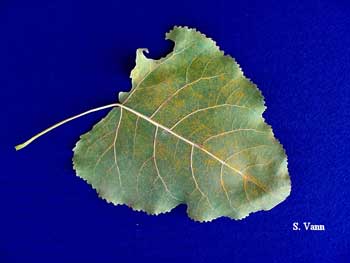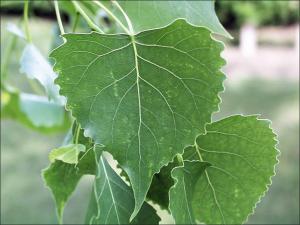cottonwood tree leaf disease
The beetle can completely defoliate a cottonwood tree. Are fairly host specific.

Colorado Master Gardener Fading Aspen Trees Steamboattoday Com
Canker disease in cottonwood trees Its a fungus-based disease that affects stressed trees which would include cottonwoods that experienced a late frost.

. The fungus spreads across the living bark and wood of the tree. Slime flux is also called wetwood. Small brownish spots appear on infected leaves in late July and early August.
Insects and disease organisms are a continuing threat to cottonwood Populus deltoides Bartr especially during the trees first 5 years. Opportunistic fungus attacks weak stressed trees - Freeze damage sunburn drought low fertility physical injuries etc. The fungus attacks weakened trees affected by drought late-spring frosts insect and fungi defoliation or trunk and root injury.
Theres also a tree disease called Canker cytospora canker that affects members of the poplar tree genus including cottonwoods. Cottonwood and Poplar Populus spp. Plant Disease Clinic many other broadleaf trees.
Uredinia containing urediniospores soon develop on infected leaves. Leaves will turn yellow to yellowish-orange in the fall. Cottonwood Tree Fluff Can Be a Nuisance to Some People Cottonwood fluff surrounds the seeds of female tree species and may cause allergy One of the unique aspects of cottonwood trees is the white soft fluff that seems to get everywhere.
Quick facts Leaf spot diseases weaken trees and shrubs by interrupting photosynthesis. Fusarium solani enters wounds particularly after major floods to cause a canker. Leaf spots and blotches appear in the spring later for walnut often following leaf veins.
Canker in cottonwoods can be easily identified by its sunken discolored areas of bark. It is caused by a bacterial infection that enters through wounds in the. These urediniospores reinfect only cottonwood.
One key to diagnosis is that you will find the fungal growth on both the upper and lower surfaces of the affected leaves. Dothichiza or Branch Canker. Cottonwoods have male and female trees and only female trees produce cotton and can be messy.
Septoria musiva causes a small canker that opens a path for other canker organisms. Leaf Beetles The cottonwood leaf beetle is 14-inch long. Leaf spot diseases should be taken seriously if they result in moderate to complete leaf.
Cytospora chrysosperma causes a canker where sites are adverse and tree vigor is low. Various plant diseases trigger gall growth but crown gall is the illness that most commonly affects cottonwoods. Cottonwood and other poplars willows fruit trees elm conifers spruce pecan.
Anthracnose Control high risk of spreading the fungal pathogen Identification On sycamore ash maple oak and walnut. Its a fungus-based disease that affects stressed trees which would include cottonwoods that experienced a late frost. Fungal disease caused by Cytospora spp.
Cottonwood Tree Diseases Insect Infestations Slime Flux. The trees are notorious for fluffy strings of seeds that get carried great distances in the breeze. Cottonless cottonwood trees may be attacked by tiny sap-sucking aphids soft and armored scale insects and mealybugs.
Black leaf spot of aspen caused by Drepanopeziza populi. Huge host range. Female and juvenile scales do not have wings legs.
Other insects that harm cottonwood trees are leaf curl mites viceroy butterflies tentmakers leaf hoppers and many other insects. Worse in years with wet springs. Numerous disease organisms attack cottonwood.
Callus tissue may form. A common Cottonwood and Poplar tree disease is Cytospora Canker. Find out all about it here.
Signs of an infestation include shoots that turn black shrivel and then die. Dark sunken cracked cankers form on twigs trunks and branches. Also active now mainly on Colorados cottonwoods the.
There are a number of borers which are attack cottonwood and elm. Four different fungus rots affect the cottonwood tree. The spots later enlarge and turn blackish are of various sizes and irregular in outline and have a yellowish to golden border.
The larvae burrow into the phloem which can severely damage young or stressed trees. However its marssonina leaf spot cytospora canker and slime flux that are the most serious problems. The seeds are enclosed in a cluster of white cottony hairs that carry them for long distances.
Cankers first appear as slightly sunken areas on the smooth bark of branches and trunks. Under favorable conditions the uredinia may develop within 1 week following infection resulting in rapid buildup of. If not treated the tree dies from girdling.
Most leaf spot diseases affect only a small percentage of the trees overall leaf area and are a minor stress on the. To avoid problems with messes try planting male cottonwood trees. Carried by the wind aeciospores infect cottonwood leaves.
Black leaf spot is common on aspen and cottonwood. Here are some things to look for in your cottonwood tree. The disease can be identified by the presence of dark brown spots or flecks on leaves which can then fuse into large black splotches on severely infected leaves.
This tree leaves disease is usually caused by the Rhytisma fungi colonizing the maple family maple proper and sycamore. Although the unsightly leaves and excessive leaf fall can be spectacular they usually cause only minimal growth loss. Leaves drop.
All of these pests have piercing sucking mouthparts that allow them to. Here is a link to the Texas Plant Disease Handbo0k information about cottonwood diseases. Leaf spot diseases may become epidemic during a wet spring and summer.
Marssonina leaf spot is caused by the Marssonina fungus and is the most common leaf disease of aspen and cottonwoods in Colorado. As with many diseases the best route of action is prevention. Scale insects are not always recognizable as insects.
Pest Diseases to Watch For As with other poplars narrowleaf cottonwood is susceptible to aphids beetle borers scales thrips anthracnose canker crown rot mistletoe and sooty mold. Several fungi cause leaf diseases on cottonwood throughout its geographic range. The disease causes dieback as the canker kills the bark and creates an oozing resin from the trunk.
There are also several leaf associated diseases that harm the cottonwood trees as well. Cottonwood is indeed susceptible to powdery mildew. The symptoms start as yellow-green or light green spots in late spring-early summer with added tar-like formations by the late summer.
The danger is intensified in large plantings of a single species and age because rapid buildup of damaging agents can occur.

Common Tree Disease Problems Symptoms And Photos Of Tree Disease

Black Leaf Spot Field Guide To Insects And Diseases Of Az And Nm Forests

Fungus May Affect Colorado S Fall Colors
Diseases Of The Fremont Cottonwood Tree

Eastern Cottonwood Natural Resource Stewardship

Plains Cottonwood Populus Deltopids Subsp Monilifera Lam Tree Service
Cottonwood Tree Leaf Disease 349992 Ask Extension

Common Diseases Of The Fremont Cottonwood Tree Gardenologist
